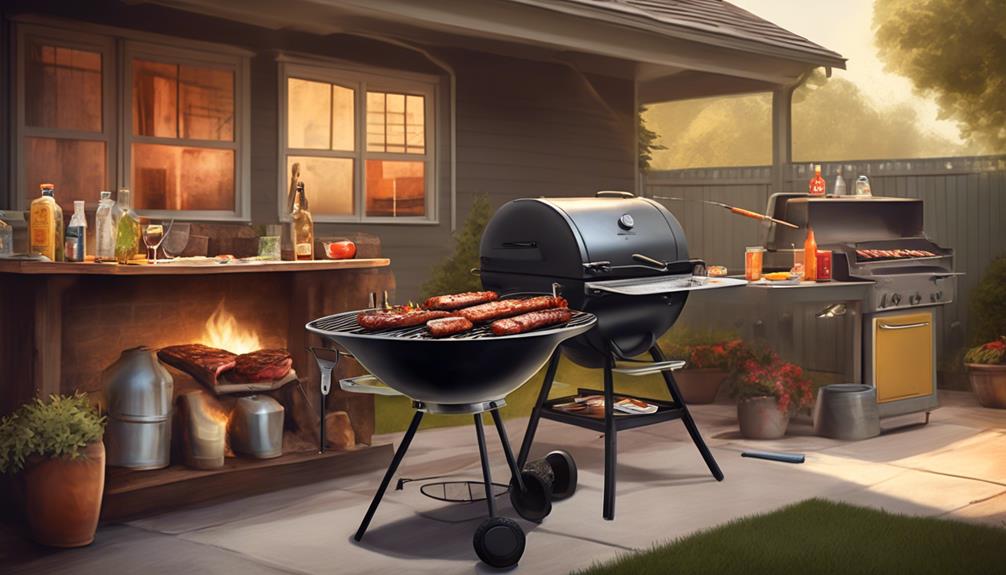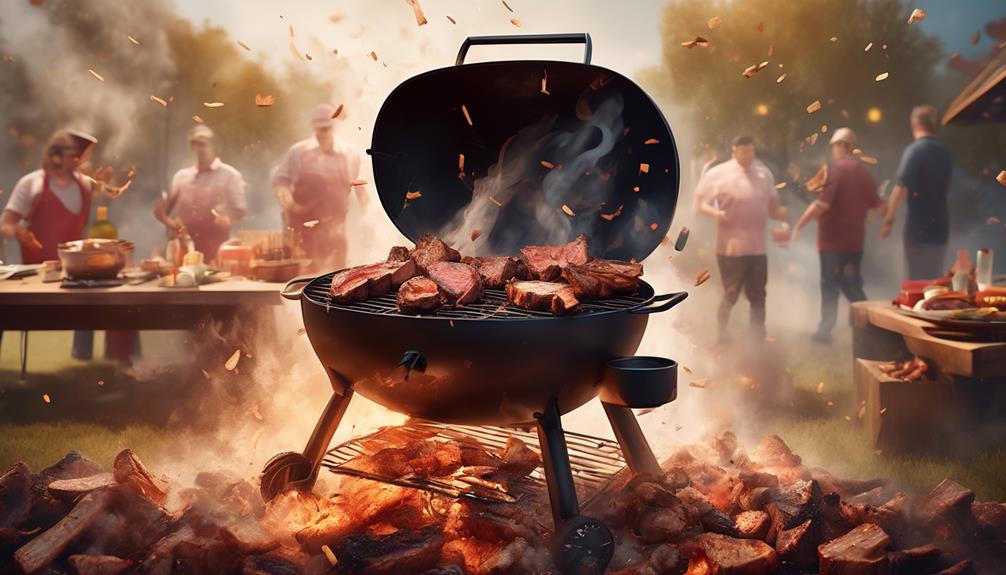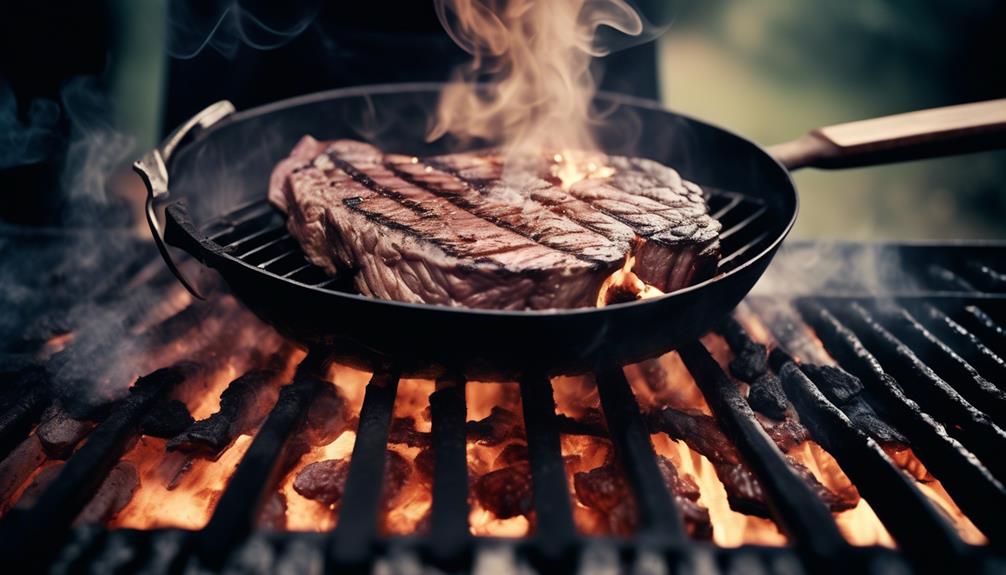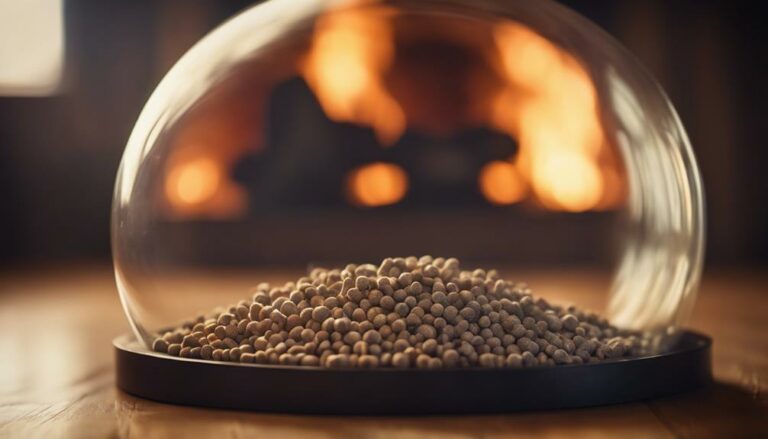Table of Contents
Barbecue cooking is an art that requires a keen understanding of techniques and a mastery of the craft. From choosing the right BBQ equipment to managing heat and cooking times, there are crucial elements that can make or break your barbecue experience.
Additionally, the preparation and seasoning of the meat, along with the use of smoke for flavor, all play pivotal roles. As we delve into the nuances of basic techniques for barbecue cooking, it becomes apparent that there is much to learn and explore in order to elevate your grilling game.
Key Takeaways
- Choosing the right BBQ equipment is important for flavor and cooking methods, considering factors such as charcoal vs. gas.
- Proper maintenance and cleaning of grill grates, checking for signs of wear and tear, and storing and covering the BBQ to prevent rust and corrosion are essential.
- Preparing and seasoning meat involves using herbs, spices, and marinade techniques, marinating overnight for deep flavor penetration, and shaking off excess marinade to prevent flare-ups.
- Managing heat and cooking times includes creating different cooking zones, monitoring heat with a temperature probe, and utilizing direct and indirect heat for different cooking techniques.
Choosing the Right BBQ Equipment

When selecting the appropriate BBQ equipment, it is essential to consider the type of barbecue that aligns with your preferred flavor and cooking methods. Whether it’s charcoal for that traditional smoky taste or gas for convenience and precise temperature control, the choice significantly impacts the overall grilling experience.
Once the right equipment is chosen, proper maintenance and storage are crucial to ensure its longevity and performance. Regular maintenance, including cleaning the grill grates, removing ash or grease buildup, and checking for any signs of wear, is vital to prevent deterioration and maintain food safety standards.
Additionally, proper storage, such as covering the barbecue when not in use and storing it in a dry area to prevent rust and corrosion, plays a pivotal role in extending the equipment’s lifespan.
Preparing and Seasoning the Meat
Having selected the appropriate BBQ equipment conducive to your preferred grilling style, the next essential step is to focus on preparing and seasoning the meat for a flavorful and satisfying barbecue experience.
Seasoning the meat is a critical aspect of barbecue cooking, as it significantly contributes to the development of rich flavors. By preparing the meat with a blend of herbs and spices before grilling, you can infuse it with complex and enticing flavors.
Utilizing marinade techniques is an effective way to enhance the flavor profile of the meat. Marinating the meat overnight allows the flavors to deeply penetrate the meat, resulting in a more pronounced and enjoyable taste. Additionally, using ready marinated options can also provide a convenient way to achieve flavor infusion.
However, it is crucial to shake off excess marinade before grilling to prevent flare-ups and ensure proper cooking. Moreover, when using oil-based marinades, it is advisable to use them sparingly to prevent excessive flare-ups and charring, which can compromise the quality of the barbecue.
Managing Heat and Cooking Times

Managing heat and cooking times are crucial aspects of successful barbecue cooking. Controlling the heat of the grill ensures that food is cooked to perfection, while accurate timing is essential for achieving the desired level of doneness.
Heat Control
To achieve optimal barbecue results, mastering heat control is essential. This involves creating varying cooking zones and ensuring precise cooking times for different cuts of meat.
Achieving temperature control is crucial. One way to do this is by adjusting the placement of coals to create hot and cooler zones for different cooking times.
Using a temperature probe to monitor the heat is essential for ensuring precise cooking times for various cuts of meat.
Understanding the correlation between flame color and temperature is also important in managing heat levels effectively.
Additionally, utilizing indirect heat for slower cooking can help achieve optimal tenderness in meats.
Lastly, mastering the art of pre-cooking is crucial for controlling core temperatures and preventing dryness, especially for larger cuts of meat.
Timing Accuracy
Mastering the art of timing accuracy is crucial for achieving optimal barbecue results, as it builds upon the foundation of heat control by ensuring precise cooking times for a variety of foods. Utilizing a timer and temperature monitoring are essential techniques for maintaining timing accuracy. Here is a breakdown of key factors to consider:
| Timing Accuracy Techniques | Description |
|---|---|
| Using a Timer | A timer is an indispensable tool for keeping track of cooking times and ensuring that foods are not undercooked or overdone. It helps maintain consistency and precision in the cooking process. |
| Temperature Monitoring | Using a meat thermometer to monitor the internal temperature of meats is vital for ensuring they are thoroughly and safely cooked. It provides an accurate gauge of doneness and helps prevent serving undercooked food. |
Grilling Directly Vs. Indirectly
When it comes to barbecue cooking, understanding the differences between grilling directly and indirectly is crucial for achieving the desired results.
Grilling directly over the heat source creates a distinct sear and caramelization, while indirect grilling allows for slower, more even cooking.
These methods not only impact the texture and flavor of the food but also play a vital role in heat control and overall cooking techniques.
Grilling Methods
Have you ever wondered about the differences between grilling directly and grilling indirectly? When it comes to grilling techniques, understanding the distinction between direct and indirect cooking is crucial.
Direct cooking is suitable for thin cuts like steaks, burgers, fish, and sausages, allowing for quick searing at higher temperatures.
On the other hand, indirect cooking is ideal for slow cooking roasting joints as it requires lower cooking temperatures and longer cooking times. To achieve indirect cooking, one can separate coals into two piles at opposite ends of the grill, creating a space in the middle for the food.
Additionally, testing the meat with a thermometer ensures it is cooked to perfection, and allowing it to rest for a few minutes enables it to reabsorb juices and become more tender.
Heat Control
Understanding the distinction between grilling directly and indirectly is crucial for controlling heat during barbecue cooking. Direct grilling is perfect for thin cuts like steaks, burgers, fish, and sausages, enhancing flavor and texture. On the other hand, indirect grilling is ideal for slow-cooking roasting joints, involving placing the meat next to, not directly over, the heat source. Temperature regulation and flame control are essential for both methods. The table below summarizes the key differences between grilling directly and indirectly:
| Aspect | Direct Grilling | Indirect Grilling |
|---|---|---|
| Heat Source | Directly under the food | Placed next to, not directly over, the heat source |
| Suitable For | Thin cuts of meat | Slow-cooking roasting joints |
| Temperature | High | Moderate to low |
| Flame Control | Direct control of flame intensity and positioning | Indirect control through adjusting heat source and airflow |
| Cooking Time | Short | Longer, for slow-cooking and roasting |
Using Smoke for Flavor

Infusing meats with distinctive smoke flavors can be achieved by using different types of wood chips, such as hickory or applewood. To fully master the art of using smoke for flavor in barbecue cooking, consider the following techniques:
- Controlling smoke intensity: Adjust the quantity of wood chips and the duration of smoking to control the intensity of the smoky flavor. This level of control allows for customization based on personal preference and the specific dish being prepared.
- Choosing wood chip combinations: Experiment with various wood chip combinations to create unique and customized smoke-infused flavors in barbecue dishes. Different types of wood impart distinct flavors, and combining them can result in complex and layered taste profiles.
- Soaking wood chips: Soaking wood chips in water before use can prolong their smoking duration and prevent them from burning too quickly. This technique not only enhances the smoking process but also contributes to a more consistent and prolonged release of flavorful smoke.
How Can I Incorporate Regional Barbecue Styles Into Basic Barbecue Cooking Techniques?
When it comes to barbecue, tasting regional barbecue styles can be a game-changer. Incorporating different flavors and techniques from regions like Texas, Kansas City, or Memphis can elevate the basic barbecue cooking. Experimenting with different spice rubs, sauces, and cooking methods can give your barbecue a unique and delicious twist.
Mastering BBQ Safety and Clean-Up
To ensure a safe and hygienic barbecue cooking environment, it is essential to master proper BBQ safety and clean-up practices.
When handling raw meat, it is crucial to prevent cross-contamination by using separate cutting boards and utensils for raw and cooked food. This practice minimizes the risk of spreading harmful bacteria from raw meat to cooked food. Additionally, it is important to wash hands and surfaces thoroughly with soap and water after coming into contact with raw meat.
Clean the grill grates with a grill brush before and after each use to remove any residue or debris that could affect the flavor and safety of the food. Furthermore, always keep a fire extinguisher nearby while barbecuing to quickly address any unexpected flare-ups or accidents.
After the barbecue session, dispose of ashes and leftover coals in a metal container and store it in a safe area, away from flammable materials.
Frequently Asked Questions
What Are BBQ Techniques?
BBQ techniques encompass a range of methods, from mastering the art of creating the perfect BBQ marinade to learning meat smoking techniques. Understanding these fundamentals elevates the barbecue experience, imparting depth and complexity to dishes.
What Is the Method of Cooking Bbq?
Mastering the art of barbecue is about more than just grilling. It involves understanding the nuances of BBQ smoking, meticulous meat preparation, and the subtle balance of heat and smoke to achieve mouthwatering, tender results.
What Are the Techniques of Grilling?
When honing outdoor cooking strategies, mastering grilling techniques is essential. Achieve optimal results by mastering direct and indirect heat, using an instant-read meat thermometer, and experimenting with marinades and rubs to elevate grilled dishes.
What Are the Steps in the Basic Barbecuing Procedure?
Basic preparation for barbecue cooking involves preheating the grill, cleaning, and oiling the grates. Essential tools include a meat thermometer and tongs. Adhere to these steps for successful grilling: sear, cook with indirect heat, and let meat rest.
Conclusion
In conclusion, mastering the art of barbecue cooking requires attention to detail and proper technique. Choosing the right equipment, preparing and seasoning the meat, managing heat and cooking times, and using smoke for flavor are all essential techniques for a successful barbecue.
Just as a painter carefully selects their colors and brushes, a barbecue chef must skillfully orchestrate these elements to create a masterpiece that will leave a lasting impression on their guests.










